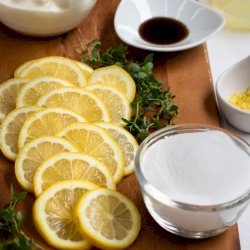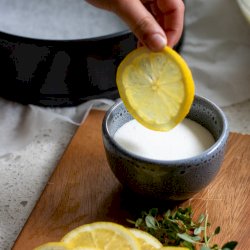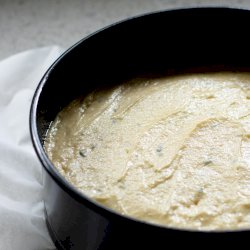Lemon Thyme Yoghurt Cake
LEMON THYME YOGHURT CAKE
The lemon thyme yoghurt cake celebrates all the ingredients I grew up with! Lemon, yoghurt, extra virgin olive oil and this super aromatic herb, thyme! The cake turns out super moist and flavourful with a good balance between sour and sweet.
It is the citrus season here in Australia at the moment so I just had to use them to create something! And in a very non-typical fashion for me, I decided to bake, to create this lemon thyme yoghurt cake. My dessert repertoire isn’t as developed as my main meals so I really wanted to make this work so you can enjoy it at home. And it absolutely worked and was well enjoyed by everyone who has tried it.
FULL FAT GREEK STYLE YOGHURT
Using full fat Greek style yoghurt is best as it doesn’t contain any stabilisers or unnecessary ingredients that low fat yoghurts do, which may affect the baking process. The yoghurt added in the lemon thyme yoghurt cake is one of the main reasons it turns out so moist and tangy (plus the lemon juice of course).
EXTRA VIRGIN OLIVE OIL
Extra virgin olive oil added gives the lemon thyme yoghurt cake a different depth of flavour which is enhanced with the lemon zest and lemon thyme leaves. Two things to notice with cakes that use good extra virgin olive oil:
1. Ensure you use good quality extra virgin olive oil as that will shine through the cake.
2. When you place the cake in the fridge it will harden as extra virgin olive oil solidifies when cold. So before you eat it you may want to warm it up slightly.
BAKING TIPS
When it comes to baking, I always find that you need to be careful not to stir too far away from a recipe given, in order to achieve the same results. The ratios of flour to fat need to balance and then of course the method of actually preparing the batter is a whole other science.
I would be the first to admit that I am not an expert baker but it is certainly something I am working on because… well I love cakes! And so when I post a cake recipe trust that I have trialed it out a number of times. And these are some pointers I learnt while trying it all out.
1. Weighing the ingredients where possible is essential. For example, when measuring flour in cups I learnt the hard way that I shouldn’t scoop the cup in the bag but instead tip the flour into the cup to measure. Otherwise, the amount of flour will be higher than that listed as it is more packed in the cup.
2. Keeping the temperature low allows the inside to cook before the outside/top layer cooks and starts cracking. And baking using the oven’s conventional setting allows for a more even colour produced in comparison to fan forced.
3. The ratios of baking soda/baking powder should be controlled to prevent cracking, which is something I observed when I first started experimenting. That is the reason I used a combination of self-raising and plain flour.
4. The size of the baking pan that was most successful was the slightly larger 22.5cm springform pan in comparison to the 20cm springform pan where I observed a lot more cracking. The extra bit of space meant that the batter had more room to move.
5. In continuation to the above point, using ingredients at room temperature means that the batter will spend less time needing to reduce in temperature in the oven. So it will start cooking in the middle before it starts cracking on the top.
6. The aluminium foil “belt” I add around the springform pan creates further depth so that the top of the batter isn’t exposed to as much heat.
Prep Time
20 mins
Cook Time
1 hr 5 mins
Cuisine: Mediterranean
Servings: 12
Ingredients
• 2 large eggs ~100g once cracked, at room temperature
• ¾ cup caster sugar, 160g
• 1 tsp vanilla essence or extract
• 1/8 tsp salt
• 1 tbs fresh lemon thyme leaves, removed from stalk
• 1 tsp lemon zest
• ¾ cup extra virgin olive oil
• ¼ cup lemon juice
• 1 cup full fat Greek style yoghurt, 260g, at room temperature
• 1 cup self-raising flour, 150g, sifted
• 1 cup plain flour, 150g, sifted
• 1 large lemon, thinly sliced
• caster sugar for coating
Instructions
1. Preheat the oven to 170°C (conventional setting or 150°C fan forced). The 2 large eggs and 1 cup of yoghurt need to reach room temperature, so allow for that first before you start measuring all the other ingredients.
2. Whisk the eggs, sugar, vanilla, salt, lemon thyme leaves and lemon zest together until they are well combined and turns into a pale mixture. Add the olive oil, lemon juice and yoghurt to the bowl with the eggs also and whisk to combine it briefly. Set aside.
3. Weigh the flour in a separate bowl and stir the two types together using the whisk to ensure they are evenly spread. Slowly sift and add the flour to the bowl with all the liquids. Stir the mixture with a wooden spoon or spatula until the flour is well combined. The batter that will be produced is thick due to the decreased whey in the Greek style yoghurt added. Set aside and then begin to assemble the cake.
4. Start by lining a 22.5cm springform pan with baking paper on the bottom and then spray some olive oil spray on the sides. Alternately you can rub extra virgin olive oil around the sides with some paper towel. Coat the lemon slices (once you removed the seeds) with sugar and then line them flat on the bottom of the pan. Depending on the size of the lemon you might need 6-8 slices.
5. Pour the cake batter into the pan and tap it on the bench a couple of times to release any excess air bubbles. Place the springform pan on a baking tray as the sugar on the lemon may leak out while caramelizing.
6. Cut a piece of aluminum foil, long enough to be able to wrap around the whole circumference of the pan. Fold the aluminum foil along its width so that it is about 10cm. Wrap the folded aluminum foil around the springform pan and fold the edges so that it remains in place. The height of the “belt” created using the aluminum foil should be its width i.e. 10cm.
7. Add the cake to the middle rack of the oven, allowing it to cook for 55min with the foil around it and the last 10min without. Check for readiness by inserting a skewer in the middle, if it comes out clean then it is ready. Leave the cake to rest on a cooling rack in the pan for 10min. After that remove the springform pan and baking paper, invert the cake on a cooling rack so that the lemon slices are now on the top. Let the cake to completely cool down on the cooling rack before cutting a piece.
8. To store the lemon thyme yoghurt cake you may leave it out of the fridge (at a cool room temperature covered for up to 3 days. If you place it in the fridge then warm up the piece of cake slightly before consuming it, because due to the extra virgin olive oil added the cake will thicken when cold.
















